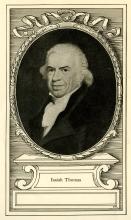New Old Letters from Isaiah Thomas
 The American Antiquarian Society recently acquired twelve letters written by its founder, Isaiah Thomas. Among them are two to William Tudor, Jr., a Boston editor (and son of the America military’s first judge advocate general). According to the A.A.S.’s Almanac newsletter:
The American Antiquarian Society recently acquired twelve letters written by its founder, Isaiah Thomas. Among them are two to William Tudor, Jr., a Boston editor (and son of the America military’s first judge advocate general). According to the A.A.S.’s Almanac newsletter:
One is a reply to Tudor’s request for Thomas’s memories of James Otis, Jr. and the other concerns a Jewish phylactery found in western Massachusetts that was regarded by some as a proof that Native Americans were descendants of the lost tribes of Israel.Thomas wrote both letters in 1819. Tudor published his Life of James Otis, of Massachusetts in 1823. Evidently the letter didn’t offer good material since the book never mentions Thomas.
And that makes sense given the trajectory of Otis and Thomas’s careers. Otis became a political foe of the royal government in the 1760s, when Thomas was still a teenaged apprentice. Thomas released himself on his own recognizance and left Boston in 1765, returning in late 1770. By then Otis had suffered his first complete breakdown and was no longer a reliable political actor, with Samuel Adams superseding him in town meetings and the Massachusetts House.
Thomas and Otis worked on the same side of the political dispute for the next thirteen years, but their paths probably didn’t cross much. The two men were from different generations and classes. Anecdotes show Otis spending more time at Edes and Gill’s Boston Gazette than at Thomas’s upstart Massachusetts Spy.
As for the Jewish phylactery or tefillin, that was a new one on me. This article by Lee M. Friedman from the American Jewish Historical Quarterly in 1917 reports that a farmer plowed it up in Pittsfield in 1815. Several gentlemen examined the scrolls written in Hebrew, including a Harvard professor, as detailed in this post at These Mysterious Hills. Eventually the tefillin was sent to Thomas, who was then collecting material for the A.A.S. And he lost track of it.
But that didn’t deter the Rev. Ethan Smith from publishing a book in 1823 (the same year as the Otis biography) arguing that the phylactery was proof that Native Americans were the Lost Tribes of Israel. One of Smith’s parishioners became a close associate of Joseph Smith (no relation), and some of the minister’s ideas appear in the earliest Mormon writings. Most scholars of the time felt, however, that the phylactery had been dropped in that field—used as a fort and a trading site—during the decades of travel by Europeans.
Years later, an A.A.S. librarian found a tefillin in the society’s collections and deduced that it was the Pittsfield phylactery.

No comments:
Post a Comment